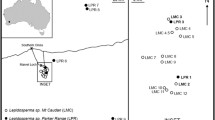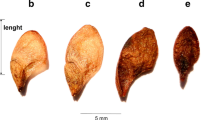Abstract
Dispersal ability is of great importance for plants, which commonly occupy spatially and temporally limited substrate patches. Mixed reproductive strategies with abundant diaspore production are favoured in a heterogeneous landscape to ensure successful colonisation at different distances. In bryophytes, long-distance dispersal has been thought to take place primarily by spores, while asexual propagules are important in local dispersal and in the maintenance of colonies. In the present study, we investigated the dispersal potential of two equally sized propagules, sexually formed spores and asexually produced gemmae in the dioecious, epixylic hepatic, Anastrophyllum hellerianum, which inhabits spatially and temporally limited substrate patches. We trapped propagules at different distances (0–10 m) and directions from the source colonies in two experiments: one in a natural habitat within a forest and another involving an artificial set-up in an open habitat. Spore dispersal showed only slight distance dependence both in the open and the forest habitats, presumably as a consequence of wind affecting the dispersal pattern. Gemma dispersal was more strongly distance-dependent in the open habitat than in the forest sites. Considerably more gemmae were deposited during rainy than dry periods, possibly because of the effect of rain drops on gemma release. However, weather conditions had no effect on the dispersal patterns of spores or gemmae. In A. hellerianum, the combination of occasional spore production and practically continuous, massive gemma production facilitates dispersal both on local scale and over long distances. Unlike previously assumed, not only spores but also the asexual propagules may contribute to long-distance dispersal, thus allowing considerable gene flow at the landscape level.
Similar content being viewed by others
References
T Ahti L Hämet-Ahti J Jalas (1968) ArticleTitleVegetation zones and their sections in northwestern Europe Ann Bot Fenn 5 169–211
I Bisang J Ehrlén (2002) ArticleTitleReproductive effort and cost of reproduction in female Dicranum polysetum Bryologist 105 384–397 Occurrence Handle10.1639/0007-2745(2002)105[0384:REACOS]2.0.CO;2
MA Bowker LR Stark DN McLetchie BD Mishler (2000) ArticleTitleSex expression, skewed sex ratios, and microhabitat distribution in the dioiecious desert moss Syntrichia caninervis (Pottiaceae) Am J Bot 87 517–526 Occurrence Handle10766723 Occurrence Handle10.2307/2656595
JM Bullock IL Moy SJ Coulson RT Clarke (2003) ArticleTitleHabitat-specific dispersal: environmental effects on the mechanisms and patterns of seed movement in a grassland herb Rhinanthus minor Ecography 26 692–704 Occurrence Handle10.1034/j.1600-0587.2003.03525.x
CJ Clark JR Poulsen BM Bolker EF Connor VT Parker (2005) ArticleTitleComparitive seed shadows of bird-, monkey-, and wind-dispersed trees Ecology 86 2684–2694
H Crum (2001) Structural diversity of bryophytes The University of Michigan Herbarium Ann Arbor
U Dieckmann B O’Hara W Weisser (1999) ArticleTitleThe evolutionary ecology of dispersal Tree 14 88–90
HJ During (1979) ArticleTitleLife history strategies of bryophytes: a preliminary rewiev Lindbergia 5 2–17
HJ During (1992) Ecological classifications of bryophytes and lichens JW Bates AM Farmer (Eds) Bryophytes and lichens in a changing environment Oxford University Press Oxford 32–76
CG Eckert (2002) ArticleTitleThe loss of sex in clonal plants Evol Ecol 15 501–520 Occurrence Handle10.1023/A:1016005519651
P-A Esseen B Ehnström L Ericson K Sjöberg (1992) Boreal forests – the focal habitats of Fennoscandia L Hansson (Eds) Ecological principles of nature conservation Elsevier Applied Science London 252–325
SR Gradstein (1993) ArticleTitleA boreal community in a tropical montane forest of Mexico Trop Bryol 9 31–34
JP Grime (2001) Plant strategies, vegetation processes, and ecosystem properties EditionNumber2 John Wiley & Sons Chichester
I Hanski (2001) Population dynamic consequences of dispersal in local populations and in metapopulations J Clobert E Danchin AA Dhondt JD Nichols (Eds) Dispersal Oxford University Press Oxford 283–298
H Hedenås VO Bolyukh BG Jonsson (2003) ArticleTitleSpatial distribution of epiphytes on Populus tremula in relation to dispersal mode J Veg Sci 14 233–242
RW Kimmerer (1991) ArticleTitleReproductive ecology of Tetraphis pellucida II. Differential success of sexual and asexual propagules Bryologist 94 284–288 Occurrence Handle10.2307/3243966
RW Kimmerer (1994) ArticleTitleEcological consequences of sexual versus asexual reproduction in Dicranum flagellare and Tetraphis pellucida Bryologist 97 20–25 Occurrence Handle10.2307/3243344
RW Kimmerer CC Young (1995) ArticleTitleThe role of slugs in dispersal of the asexual propagules of Dicranum flagellare Bryologist 98 149–153 Occurrence Handle10.2307/3243652
M Kuusinen A Penttinen (1999) ArticleTitleSpatial pattern of the threatened epiphytic bryophyte Neckera pennata at two scales in a fragmented boreal forest Ecography 22 729–735 Occurrence Handle10.1111/j.1600-0587.1999.tb00522.x
S Laaka-Lindberg (1999) ArticleTitleAsexual reproduction in a population of a leafy hepatic species Lophozia silvicola Buch in central Norway Plant Ecol 141 137–144 Occurrence Handle10.1023/A:1009849115595
S Laaka-Lindberg (2000) ArticleTitleSubstrate preference and reproduction in Lophozia silvicola (Hepaticopsida) in southern Finland Ann Bot Fenn 37 85–93
S Laaka-Lindberg (2005) ArticleTitleReproductive phenology in the leafy hepatic Lophozia silvicola Buch in southern Finland J Bryol 27 253–259 Occurrence Handle10.1179/174328205X70001
S Laaka-Lindberg TA Hedderson RE Longton (2000) ArticleTitleRarity and reproductive characters in the British hepatic flora Lindbergia 25 78–84
S Laaka-Lindberg H Korpelainen M Pohjamo (2003) ArticleTitleDispersal of asexual propagules in bryophytes J Hattori Bot Lab 93 319–330
S Laaka-Lindberg M Pohjamo H Korpelainen (2005) ArticleTitleNiche breadth and niche overlap in three epixylic hepatics in a boreal old-growth forest, southern Finland J Bryol 27 119–127 Occurrence Handle10.1179/037366805X53031
R Longton (1992) ArticleTitleReproduction and rarity in British mosses Biol Conserv 59 151–154 Occurrence Handle10.1016/0006-3207(92)90566-6
RE Longton RM Schuster (1983) Reproductive biology RM Schuster (Eds) New manual of bryology NumberInSeries1 Hattori Botanical Laboratory Nichinan 386–462
CB McQueen (1985) ArticleTitleSpatial pattern and gene flow distances in Sphagnum subtile Bryologist 88 333–336 Occurrence Handle10.2307/3242668
CJ Miles RE Longton (1992) ArticleTitleDeposition of moss spores in relation to distance from parent gametophytes J Bryol 17 355–368
NG Miller SF McDaniel (2004) ArticleTitleBryophyte dispersal inferred from colonization of an introduced substratum on Whiteface Mountain, New York Am J Bot 91 1173–1182
BD Mishler (1988) Reproductive biology of bryophytes J Lovett Doust L Lovett Doust (Eds) Plant reproductive ecology. Pattern and strategies Oxford University Press Oxford 285–306
J Muñoz AM Felicisimo F Cabezas AR Burgaz I Martinez (2004) ArticleTitleWind as a long-distance dispersal vehicle in the Southern Hemispere Science 304 1144–1147 Occurrence Handle15155945 Occurrence Handle10.1126/science.1095210
DJ Murrel JMJ Travis C Dytham (2002) ArticleTitleThe evolution of dispersal distance in spatially-structured populations Oikos 97 229–236 Occurrence Handle10.1034/j.1600-0706.2002.970209.x
R Nathan UN Safriel I Noy-Meir (2001) ArticleTitleField validation and sensitivity analysis of a mechanistic model for tree seed dispersal by wind Ecology 82 374–388 Occurrence Handle10.2307/2679866
LM O’Connel CG Eckert (2001) ArticleTitleDifferentiation in reproductive strategy between sexual and asexual populations of Antennaria parlinii (Asteraceae) Evol Ecol Res 3 311–330
WA Ozinga RM Bekker JHJ Schaminée JM Groenendael ParticleVan (2004) ArticleTitleDispersal potential in plant communities depends on environmental conditions J Ecol 92 767–777 Occurrence Handle10.1111/j.0022-0477.2004.00916.x
JA Paton (1999) The liverwort flora of the British Isles Harley Books Colchester
M Pohjamo S Laaka-Lindberg (2003) ArticleTitleReproductive modes in a leafy hepatic Anastrophyllum hellerianum Persp Plant Ecol Evol Syst 6 159–168 Occurrence Handle10.1078/1433-8319-00074
M Pohjamo S Laaka-Lindberg (2004) ArticleTitleDemographic population structure of the leafy hepatic Anastrophyllum hellerianum Plant Ecol 173 73–81 Occurrence Handle10.1023/B:VEGE.0000026330.62021.0a
Påhlsson L (ed) (1994) Vegetationstyper i Norden. Tema Nord 1994, 995. Nordiska ministerreеdet
E Roads R Longton (2003) ArticleTitleReproductive biology and populations studies in two annual shuttle mosses J Hattori Bot Lab 93 305–318
K Rydgren R Økland (2002) ArticleTitleSex distribution and sporophyte frequency in a population of the clonal moss Hylocomium splendens J Bryol 24 207–214 Occurrence Handle10.1179/037366802125001376
K Rydgren R Økland (2003) ArticleTitleShort-term costs of sexual reproduction in the clonal moss Hylocomium splendens Bryologist 106 212–220 Occurrence Handle10.1639/0007-2745(2003)106[0212:SCOSRI]2.0.CO;2
Rydgren K, Cronberg N, Økland R (2006) Factors influencing reproductive success in the clonal moss, Hylocomium splendens. Oecologia (in press)
AJ Shaw (2000) Population ecology, population genetics, and microevolution AJ Shaw B Goffinet (Eds) Bryophyte biology Cambridge University Press Cambridge 369–402
AJE Smith (1996) Moss flora of Britain and Ireland Cambridge University Press Cambridge
T Snäll PJ Ribeiro H Rydin (2003) ArticleTitleSpatial occurrence and colonizations in patch-tracking metapopulations: local conditions versus dispersal Oikos 10 566–578 Occurrence Handle10.1034/j.1600-0706.2003.12551.x
T Snäll J Ehrlen H Rydin (2005) ArticleTitleColonization-extinction dynamics of an epiphyte metapopulation in a dynamic landscape Ecology 86 106–115
A Stoneburner DM Lane LE Anderson (1992) ArticleTitleSpore liberation distances in the moss Atrichum angustatum (Polytrichaceae) Bryologist 95 324–328 Occurrence Handle10.2307/3243491
J Stöcklin E Winkler (2004) ArticleTitleOptimum reproduction and dispersal strategies of a clonal plant in a metapopulation: a simulation study with Hieracium pilosella Evol Ecol 18 563–584 Occurrence Handle10.1007/s10682-004-5144-6
S Sundberg (2005) ArticleTitleLarger capsules enhance short-range dispersal in Sphagnum, but what happens further on? Oikos 108 115–124 Occurrence Handle10.1111/j.0030-1299.2005.12916.x
L Söderström T Herben (1997) ArticleTitleDynamics of bryophyte metapopulations Adv Bryol 6 205–240
L Söderström B-G Jonsson (1989) ArticleTitleSpatial pattern and dispersal in the leafy hepatic Ptilidium pulcherrimum J Bryol 15 793–802
O Tackenberg (2003) ArticleTitleModeling long-distance dispersal of plant diaspores by wind Ecol Monogr 73 173–189
O Tackenberg P Poshlod S Bonn (2003) ArticleTitleAssessment of wind dispersal potential in plant species Ecol Monogr 73 191–205
BO Zanten Particlevan (1978) ArticleTitleExperimental studies on trans-oceanic long-range dispersal of moss spores in the Southern Hemisphere J Hattori Bot Lab 44 455–482
BO Zanten Particlevan T Pócs (1981) ArticleTitleDistribution and dispersal of bryophytes Adv Bryol 1 479–562
Author information
Authors and Affiliations
Corresponding author
Rights and permissions
About this article
Cite this article
Pohjamo, M., Laaka-Lindberg, S., Ovaskainen, O. et al. Dispersal potential of spores and asexual propagules in the epixylic hepatic Anastrophyllum hellerianum . Evol Ecol 20, 415–430 (2006). https://doi.org/10.1007/s10682-006-0011-2
Received:
Accepted:
Issue Date:
DOI: https://doi.org/10.1007/s10682-006-0011-2




